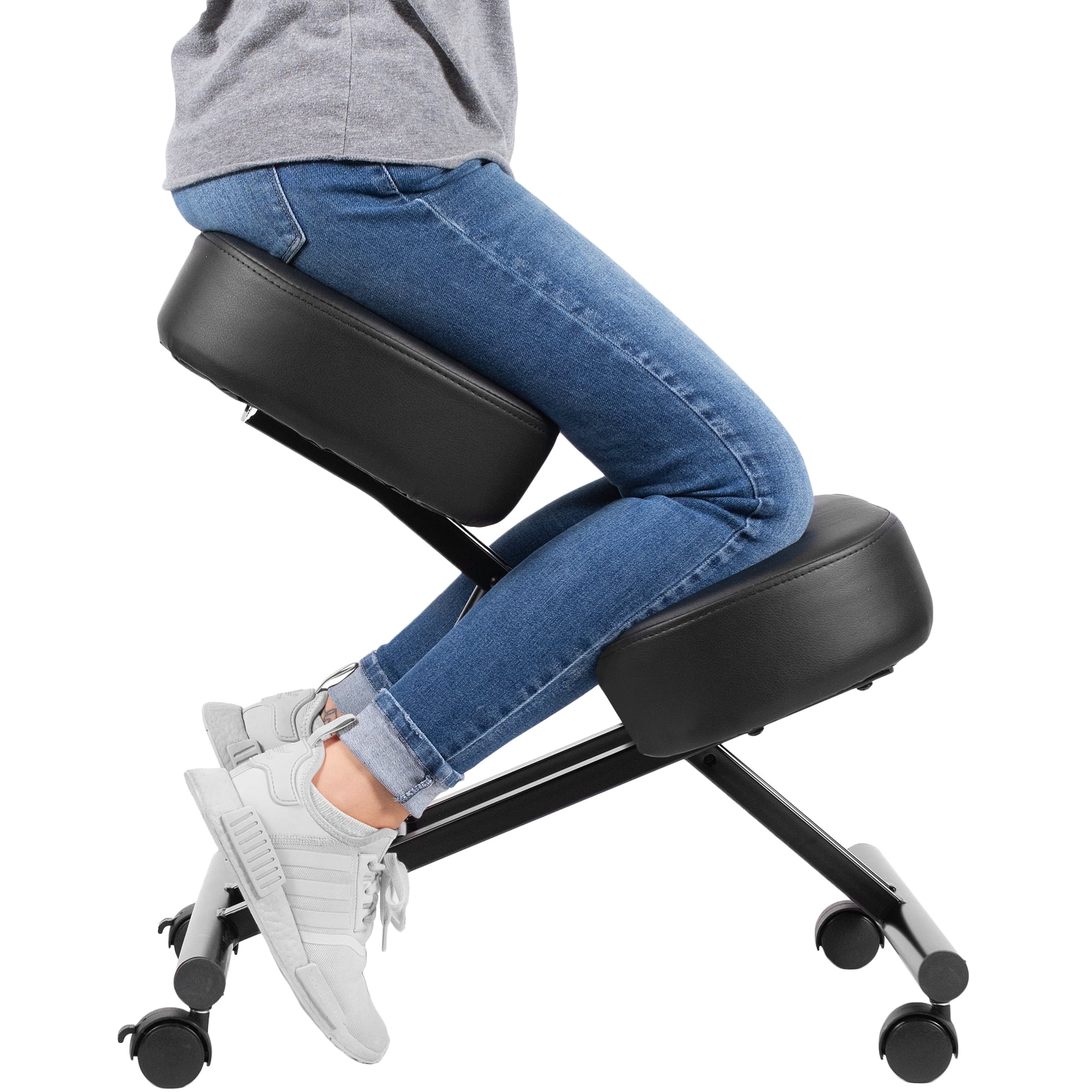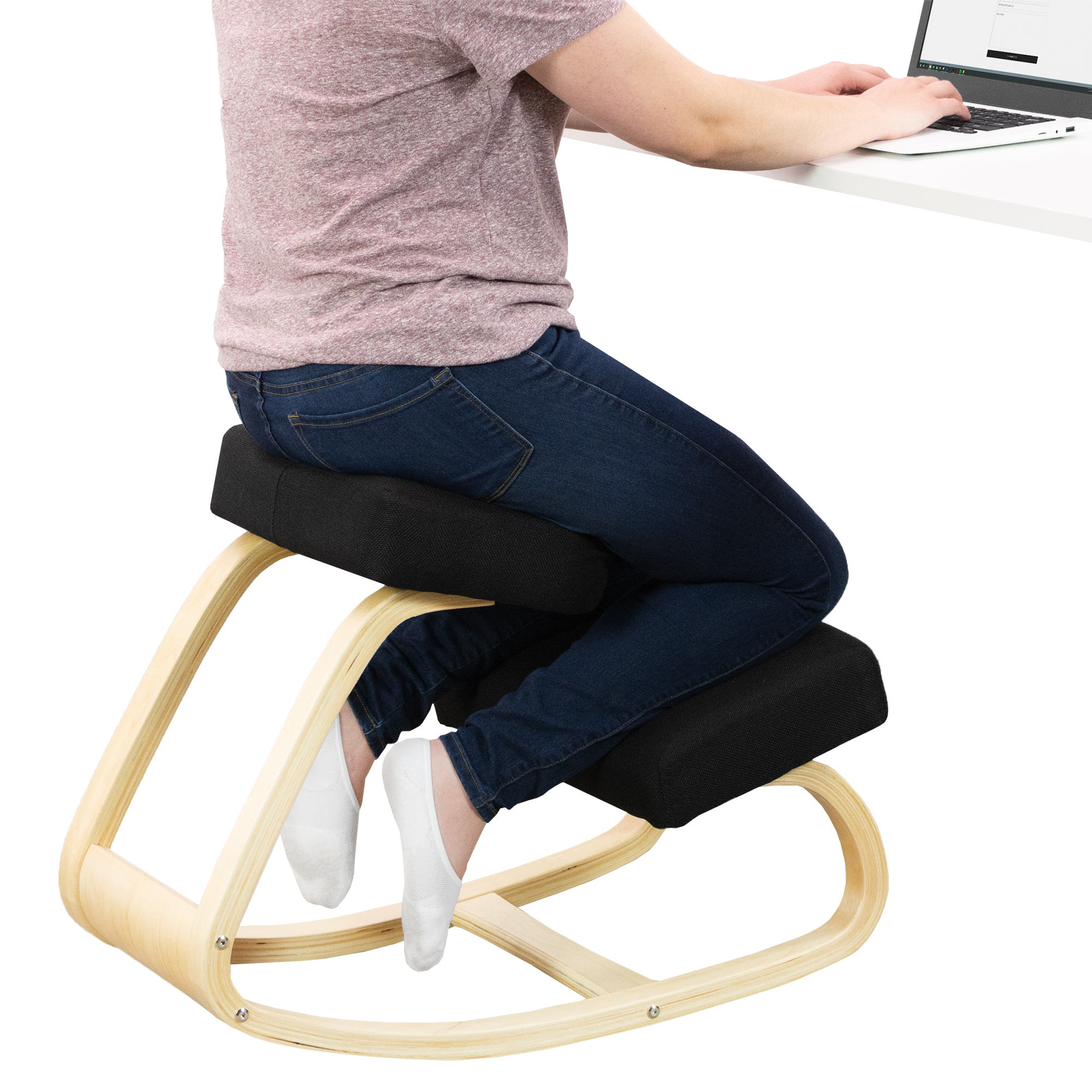Ergonomic Benefits of Kneeling Chairs

Kneeling chairs offer a unique approach to seated posture, aiming to alleviate common back problems associated with traditional office chairs. By shifting weight distribution and encouraging a more upright posture, they can significantly improve spinal alignment and reduce strain on the lower back. This approach is particularly beneficial for individuals who spend extended periods sitting at a desk.
Ergonomic kneeling chair by uplift desk – The fundamental difference lies in how kneeling chairs support the body. Unlike traditional chairs that encourage slumping, kneeling chairs promote a more natural posture by supporting the user’s knees and shins while keeping the hips slightly elevated. This angled posture helps maintain the natural curves of the spine, reducing pressure on the lower back and promoting better spinal alignment. The adjusted hip and knee angles also encourage better circulation and reduce pressure on the thighs and buttocks.
Postural Advantages of Kneeling Chairs
Kneeling chairs offer several postural advantages over traditional office chairs. The most significant benefit is the improved spinal alignment. By encouraging an upright posture, they help maintain the natural “S” curve of the spine, reducing the strain on the intervertebral discs and minimizing the risk of lower back pain. The elevated hip position opens up the hip flexors, preventing tightness and discomfort in this area. This posture also improves the angle of the knees, reducing pressure on the joints and promoting better blood circulation in the legs. Furthermore, the reduced pressure on the lower back can be particularly beneficial for individuals suffering from conditions like sciatica or lower back pain.
Kneeling Chair Suitability for Different Body Types and Conditions
The suitability of a kneeling chair depends on individual body type and pre-existing conditions. While generally beneficial, certain considerations apply.
| Body Type | Condition | Benefits/Drawbacks |
|---|---|---|
| Average Build | None | Generally comfortable and beneficial for improved posture and reduced lower back strain. |
| Overweight | None | May require a chair with extra support and padding to accommodate weight. Potential for increased knee pressure. |
| Tall | None | May require a chair with adjustable height to ensure proper knee and hip angles. |
| Short | None | May need to use a footrest to maintain proper posture and leg support. |
| Average Build | Lower back pain | Can provide significant relief by reducing pressure on the lower back and improving spinal alignment. However, individual response varies. |
| Average Build | Knee problems (arthritis) | May exacerbate existing knee pain. Careful consideration and consultation with a physician are advised. |
Ergonomic Support in the Uplift Desk Kneeling Chair, Ergonomic kneeling chair by uplift desk
The Uplift Desk kneeling chair incorporates several design features to enhance ergonomic support. Its unique contoured seat and knee pads are designed to distribute weight evenly across the thighs and shins, minimizing pressure points and promoting proper posture. The adjustable height allows users to customize the chair to their individual body dimensions, ensuring optimal knee and hip angles. The chair’s sturdy construction and high-quality materials provide long-lasting support and durability. The angled seat encourages an upright posture, maintaining the natural curvature of the spine and reducing strain on the lower back. The knee pads are padded to provide comfort and prevent discomfort during extended use. These features work in concert to promote a healthy and comfortable sitting experience.
Kneeling Chair Usage and Adjustments: Ergonomic Kneeling Chair By Uplift Desk

Transitioning to a kneeling chair can significantly improve your posture and reduce back pain, but proper setup and adjustment are crucial for maximizing its benefits. Understanding how to use your Uplift Desk kneeling chair correctly will ensure you reap the rewards of this ergonomic seating solution. This section details the process of adjusting your chair and addresses common challenges faced by new users.
Proper Adjustment and Usage of an Uplift Kneeling Chair
Proper adjustment is key to reaping the benefits of a kneeling chair. Follow these steps for optimal comfort and ergonomic support.
- Find the Right Knee Pad Position: Adjust the knee pad’s height and angle so your knees are comfortably bent at approximately a 90-degree angle. Your shins should rest comfortably on the knee pad, with your feet flat on the floor. Avoid excessive pressure on your knees.
- Adjust the Seat Height: Ensure the seat height allows your hips to be slightly elevated above your knees. This promotes a natural posture and reduces strain on your lower back.
- Maintain Proper Back Posture: Your back should remain straight, with a slight natural curve in your lower back. Avoid slouching or hunching over. Your shoulders should be relaxed and down.
- Regularly Check Your Posture: Throughout the day, take short breaks to check your posture and readjust the chair as needed. Consistency is key to avoiding discomfort and maintaining proper ergonomic alignment.
- Experiment and Fine-Tune: Every body is different. Experiment with the various adjustments to find the position that feels most comfortable and supportive for *your* body. It may take some time to find the perfect setup.
Challenges of Transitioning to a Kneeling Chair and Solutions
While kneeling chairs offer many benefits, some users initially experience discomfort. Understanding these challenges and implementing appropriate solutions can help ensure a smooth transition.
- Knee Discomfort: Initial knee discomfort is common. Gradually increase your usage time to allow your knees to adjust. Use cushions or padding on the knee pad if needed. Consider taking short breaks to stand and stretch your legs.
- Lower Back Pain: This can occur if the chair isn’t adjusted correctly. Ensure your hips are slightly higher than your knees and your back remains straight. Proper posture is paramount to avoiding lower back pain.
- Numbness in Legs or Feet: This might indicate poor circulation. Ensure your feet are flat on the floor and that your knees aren’t compressed. Regularly move your legs and feet to improve blood flow.
- Feeling Uncomfortable or Restricted: This is often a matter of adjustment. Experiment with the chair’s settings, and take breaks to move around. Remember, it may take time to fully adapt to this new seating position.
Ideal Posture in a Kneeling Chair
Imagine a straight line running from your ears, through your shoulders, and down to your hips. Your hips are slightly elevated above your knees, creating a gentle forward tilt of your pelvis. Your knees are bent at approximately a 90-degree angle, resting comfortably on the knee pad. Your feet are flat on the floor, providing a stable base of support. Your back is straight, maintaining its natural curves, with your shoulders relaxed and your head held high. This posture promotes proper spinal alignment and reduces strain on your back and neck.
Comparison with Traditional Office Chairs

Choosing between a kneeling chair and a traditional office chair significantly impacts long-term health and comfort. While traditional chairs offer familiarity and comfort for some, kneeling chairs present a distinct alternative designed to promote better posture and reduce strain on the back and spine. This comparison explores the long-term health implications of each.
Understanding the differences between these chair types requires considering their impact on posture, back health, and overall musculoskeletal well-being. The following table summarizes key contrasts.
Long-Term Health Implications: Kneeling vs. Traditional Chairs
| Kneeling Chair | Traditional Chair |
|---|---|
| Promotes upright posture, reducing slouching and spinal curvature. This can alleviate lower back pain and improve spinal alignment over time. | Often encourages slouching, which can lead to increased pressure on the spine, potentially causing or worsening back pain, neck pain, and headaches. Poor posture can also contribute to rounded shoulders and forward head posture. |
| Encourages a more natural distribution of weight, reducing pressure on the lower back and improving blood circulation. This can lead to less fatigue and improved energy levels. | Can concentrate weight on the tailbone and lower back, leading to discomfort and potential long-term problems. Poor circulation in the legs can also result from prolonged sitting. |
| Strengthens core muscles as the user maintains balance and an upright posture. This contributes to overall improved body strength and stability. | Can weaken core muscles due to lack of engagement and prolonged sedentary posture. This can increase vulnerability to back injuries and other musculoskeletal problems. |
| May reduce hip and knee stiffness by promoting a more dynamic posture and encouraging movement throughout the day. | Can contribute to hip and knee stiffness due to prolonged sitting in a static position. |
Real-World Examples of Transitions
Consider these fictional yet realistic examples:
Sarah, a graphic designer, suffered from chronic lower back pain after years of using a traditional office chair. Switching to a kneeling chair resulted in a significant reduction in her pain within a few months. She attributes this improvement to the improved posture and weight distribution. Her core strength also increased, further enhancing her overall comfort and reducing her reliance on pain medication.
Mark, a software engineer, experienced persistent neck and shoulder tension from prolonged periods of hunching over his keyboard. After adopting a kneeling chair, he noticed a gradual improvement in his posture and a decrease in his neck and shoulder pain. He found the chair encouraged him to take more frequent breaks, further aiding his musculoskeletal health.
A Direct Comparison: Kneeling vs. Traditional Chairs
Traditional office chairs, while comfortable in the short term, often contribute to poor posture and subsequent back problems. The sedentary nature of sitting for extended periods can weaken core muscles and increase the risk of lower back pain, neck pain, and other musculoskeletal issues. Conversely, kneeling chairs actively encourage good posture by promoting a more upright sitting position. This upright posture distributes weight more evenly, reducing strain on the lower back and improving spinal alignment. The increased engagement of core muscles contributes to better stability and overall body strength. While the initial transition to a kneeling chair may feel unusual, the long-term benefits for posture and back health often outweigh the initial adjustment period. The key is finding the right chair and adjusting it properly to meet individual needs.
